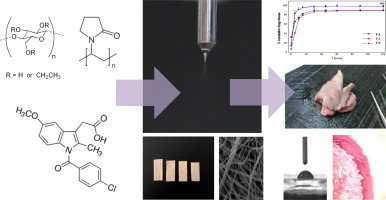Polymer based dosages form the mainstay of drug delivery systems either as simple matrix carrier materials or active release behaviour modulating agents. In addition, several techniques have been
developed further to deliver novel polymeric structures. One such method is electrospinning (ES); a maturing process which is operational at the ambient environment and enables drug loading (in
molecularly dispersed form) directly into a fibrous polymer matrix system. Since there is an impending need to address healthcare challenges arising from an increase in the aging population
(requiring enhanced treatments), the ES method was used to develop fibrous polymer composite-indomethacin (INDO) films for potential use in the buccal region. Films were assessed for their
inter-facial behaviour at bio-interfaces (in-vitro and ex-vivo). Polymeric excipients possessing
an established profile for commercial dosage form development were selected. Fibrous films (all fibre components <400nm) were characterised using DSC, TGA, FTIR, Raman and XRD. DSC and XRD
demonstrated INDO change from crystalline to amorphous state. FTIR and Raman data suggest INDO, PVP and co-polymers (Methocel ™ E5, Methocel ™ E15 and Tween® 80) were integrated in stable
fashion into filamentous structures via ES.Variable INDO release behaviour from several matrices was observed suggesting a potential route to tailor drug release based on polymeric
excipient use and ratio. Furthermore, permeation studies using a porcine buccal model demonstrated sustained permeation once dosages are attached to the buccal mucosa. The insoluble nature of
cellulose excipients were used to promote sustained release while the use of Tween®80 surfactant was used to enhance permeation of INDO through polymer interaction with excised tissue. Finally,
histology studies indicate polymer excipient selection impacts the bio-interface. In summary, a facile approach to formulate, encapsulate and engineer fibrous polymeric buccal films (on demand) is
shown. The method enables drug dispersion directly within the composite polymeric system, which has a clear impact on drug release, in-vitro and ex-vivo bio-interaction.
- Home
- Blog
- News
- Basics
- Sources
- Agencies, Regulatory & Organisations
- CERSI Excipients Browser
- Excipient Report
- Excipient DMF List
- EXCiPACT Certified Companies
- Excipient Documentation
- Excipient EINECS Numbers
- Excipient E-Numbers
- FDA Inactive Ingredient List
- FDA GRAS Substances (SCOGS) Database
- IPEC Americas
- USP - U.S. Pharmacopeia
- Definitions
- Whitepapers / Publications
- Supplier
- Services
- Media
- Events
- 1st pharmaexcipients Poster Award
- Event Calendar
- Events featured by pharma-excipients
- 4th Annual Formulation & Drug Delivery Congress
- DDF Summit
- ExcipientFest Americas
- ExcipientFest Asia
- Global CompliancePanel
- International Conference and Exhibition on Pharmaceutics & Novel Drug Delivery Systems
- Formulation & Drug Delivery USA Congress
- Laboratory Medicine 2018
- Making Pharmaceuticals Europe
- Making Pharmaceuticals Exhibition
- Pharma Integrates
- PharmaExcipients China @CPhI China
- TTC Technology Training Center
- Jobs
- Online Sourcing
- Contact

